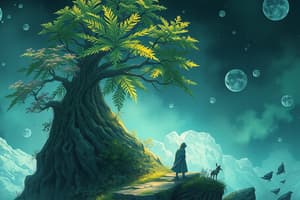Podcast
Questions and Answers
What is an ecosystem composed of?
What is an ecosystem composed of?
- A group of different species that live in the same area
- Only non-living things in an area
- The community of plants and animals living in an area and the non-living things there too (correct)
- Only plants and animals
What is the process called when a plant grows toward the light?
What is the process called when a plant grows toward the light?
- Phototropism (correct)
- Germination
- Photosynthesis
- Echolocation
Which of the following animals have a backbone?
Which of the following animals have a backbone?
- Invertebrates
- Worms, insects, and spiders
- Mammals, reptiles, birds, amphibians, and fish (correct)
- Jellyfish and sponges
What is the term for the ability of some animals to sense and respond to Earth’s magnetic field?
What is the term for the ability of some animals to sense and respond to Earth’s magnetic field?
What is the process called when a plant grows from seed to sprout?
What is the process called when a plant grows from seed to sprout?
What is the term that refers to a group of different species that live in the same area?
What is the term that refers to a group of different species that live in the same area?
Which of the following animals does NOT have a backbone?
Which of the following animals does NOT have a backbone?
What is the term for the process by which plants make their own food using light, water, and carbon dioxide?
What is the term for the process by which plants make their own food using light, water, and carbon dioxide?
What is the term for an animal that moves on four legs?
What is the term for an animal that moves on four legs?
What is the term for an external skeleton?
What is the term for an external skeleton?
What is the term for the way animals emit calls out to their environment and listen to the echoes to navigate through spaces?
What is the term for the way animals emit calls out to their environment and listen to the echoes to navigate through spaces?
A species is a single plant or animal.
A species is a single plant or animal.
Phototropism is the process by which plants make their own food using light, water, and carbon dioxide.
Phototropism is the process by which plants make their own food using light, water, and carbon dioxide.
All vertebrates have a backbone.
All vertebrates have a backbone.
Insects are vertebrates.
Insects are vertebrates.
Locomotion refers to the ability of some animals to sense and respond to Earth’s magnetic field.
Locomotion refers to the ability of some animals to sense and respond to Earth’s magnetic field.
Match the following terms with their definitions:
Match the following terms with their definitions:
Match the following animal types with their characteristics:
Match the following animal types with their characteristics:
Match the following plant life cycle stages with their order:
Match the following plant life cycle stages with their order:
Match the following plant leaf jobs with their descriptions:
Match the following plant leaf jobs with their descriptions:
Flashcards are hidden until you start studying
Study Notes
Classification of Living Things
- Organism: a single plant or animal
- Species: a group of organisms
- Community: a group of different species that live in the same area
- Ecosystem: the community of plants and animals living in an area and the non-living things there too
Animal Types
- Vertebrate: animals that have a backbone (e.g., mammals, reptiles, birds, amphibians, and fish)
- Invertebrate: animals without a backbone (e.g., worms, insects, spiders, jellyfish, and sponges)
- Mammals: characteristics include hair, warm-blooded, and milk production
- Reptiles: characteristics include scaly skin, cold-blooded, and laying eggs
- Amphibians: characteristics include moist skin, cold-blooded, and laying eggs
- Fish: characteristics include gills, cold-blooded, and laying eggs
- Birds: characteristics include feathers, warm-blooded, and laying eggs
- Insects: characteristics include exoskeleton, multiple limbs, and bilateral symmetry
- Spiders: characteristics include eight legs, no wings, and bilateral symmetry
- Worms: characteristics include soft body, no limbs, and bilateral symmetry
Plant Biology
- Phototropism: when a plant grows toward the light
- Germination: when a plant grows from seed to sprout
- Photosynthesis: plant process of making food using light, water, and carbon dioxide
- 5 basic needs of plants: light, water, air, soil, and nutrients
- 3 main jobs of plant leaves: making food, breathing, and regulating water
Plant Life Cycle
- Stage 1: seed germination
- Stage 2: growth
- Stage 3: reproduction
- Stage 4: pollination
- Stage 5: seed dispersal
Animal Movement and Sensing
- Locomotion: how animals move from one place to another
- Bipedal: moving on two legs
- Quadruped: moves using 4 legs
- Echolocation: how animals emit calls out to the environment and listen to the echoes that tell them where they are and navigate through spaces
- Infrared sensing: the ability to detect infrared radiation
- Magnetoreception: the ability of some animals to sense and respond to Earth’s magnetic field
Studying That Suits You
Use AI to generate personalized quizzes and flashcards to suit your learning preferences.




